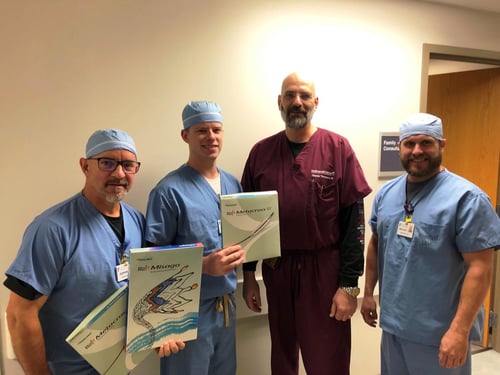Dr. Charles Thompson, interventional cardiologist at Cardiovascular Institute of the South in Zachary, is the first in the Baton Rouge region, and second in the state, to use the R2P™ MISAGO® RX self-expanding stent, the longest stent platform that is specifically designed for above-the-knee peripheral artery disease (PAD) interventions via radial access through the wrist. The procedure took place on October 31 at Lane Regional Medical Center.
Manufactured by Terumo Interventional Systems, this self-expanding peripheral stent incorporates Rapid Exchange (RX) technology and innovative bare metal stent design. The increased flexibility lowers the potential for stent fracture, and the simplified thumbwheel system allows for single and precise operator deployment. This stent is used with the R2P™ METACROSS RX PTA Balloon Dilatation Catheter, also manufactured by Terumo, with the longest radial to peripheral capability.
“This is a game changer,” explained Dr. Thompson. “It allows for more patient comfort by offering a mechanism to treat both legs in a single procedure, reducing cost for the patient and hospital. Plus, there is a lower risk with the use of radial artery access in the wrist rather than femoral artery access in the groin.”
This stent is used to treat a condition called peripheral artery disease, which is caused by plaque build-up or blockages in the legs. Just like clogged arteries in the heart, blocked arteries in the legs keep the organs from receiving oxygen-rich blood, which raises the risk of cardiovascular events, such as heart attacks and strokes. PAD is a common and treatable disease, but it is often unrecognized and undiagnosed. Ultimately, PAD can reduce mobility and lead to amputation if left untreated.
Symptoms of PAD in the legs include: pain or cramping after activity, numbness, coldness, sores or ulcers that won’t heal, discoloration, hair loss, shiny skin or a weak pulse. The risk for developing PAD increases with age and is highest for those over 50 years old. Smoking increases the chance of developing PAD three to five times. Other common risk factors include diabetes, high blood pressure, abnormal cholesterol levels, and a family history of vascular disease, heart attack or stroke.
To schedule an appointment at Cardiovascular Institute of the South in Zachary, call 225-654-1559.

James Pierce, RT; Joe Pierce, RT; Dr. Charles Thompson, and Bennett Templet, RT




